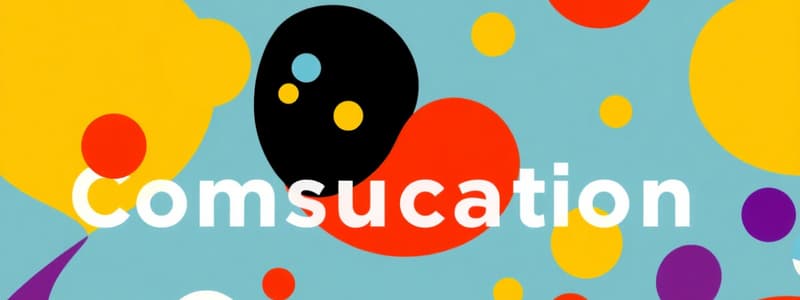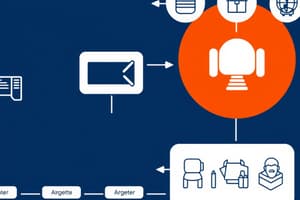Podcast
Questions and Answers
What is the main purpose of encoding in the communication process?
What is the main purpose of encoding in the communication process?
- Transmitting a message through a specific channel
- Providing feedback to the receiver
- Ensuring the message is received successfully
- Converting the message into symbols (correct)
Who is responsible for the encoding of a message?
Who is responsible for the encoding of a message?
- The receiver
- The channel of communication
- The software used for communication
- The sender (correct)
Which component comes immediately after encoding in the communication process?
Which component comes immediately after encoding in the communication process?
- Channel (correct)
- Feedback
- Decoding
- Receiver
What role does the channel play in communication?
What role does the channel play in communication?
Which of the following statements about the communication process is true?
Which of the following statements about the communication process is true?
Which of the following actions is recommended to show attentiveness while communicating?
Which of the following actions is recommended to show attentiveness while communicating?
What is an appropriate way to encourage further conversation from the speaker?
What is an appropriate way to encourage further conversation from the speaker?
Which statement reflects an effective verification technique during a conversation?
Which statement reflects an effective verification technique during a conversation?
What is the best question to seek clarification on a speaker's message?
What is the best question to seek clarification on a speaker's message?
What should someone do if they are unable to take notes during a conversation?
What should someone do if they are unable to take notes during a conversation?
What is a key structural characteristic of vectors?
What is a key structural characteristic of vectors?
How does the size change of a vector image affect its quality?
How does the size change of a vector image affect its quality?
Which of the following is a common use of vector graphics?
Which of the following is a common use of vector graphics?
What is a primary benefit of using vector graphics over other types?
What is a primary benefit of using vector graphics over other types?
In what way do vectors differ from raster graphics?
In what way do vectors differ from raster graphics?
What is a key factor for successful presentations related to audience interaction?
What is a key factor for successful presentations related to audience interaction?
Which of the following best summarizes the importance of being prepared for presentations?
Which of the following best summarizes the importance of being prepared for presentations?
How does having a good grip on your topic contribute to a successful presentation?
How does having a good grip on your topic contribute to a successful presentation?
What should be included in the conclusion of a successful presentation?
What should be included in the conclusion of a successful presentation?
What emotional aspect is essential for presentation success according to the factors listed?
What emotional aspect is essential for presentation success according to the factors listed?
What is considered a significant disadvantage of written communication?
What is considered a significant disadvantage of written communication?
Which of the following options is NOT a disadvantage of written communication?
Which of the following options is NOT a disadvantage of written communication?
Why might written communication be considered expensive?
Why might written communication be considered expensive?
Which statement highlights a challenge associated with written communication?
Which statement highlights a challenge associated with written communication?
What aspect of written communication can lead to significant time loss?
What aspect of written communication can lead to significant time loss?
What is a significant advantage of oral communication?
What is a significant advantage of oral communication?
Which statement correctly identifies a disadvantage of oral communication?
Which statement correctly identifies a disadvantage of oral communication?
Why might oral communication be preferred in emergencies?
Why might oral communication be preferred in emergencies?
Which of these is NOT an advantage of oral communication?
Which of these is NOT an advantage of oral communication?
An effective use of oral communication often relies on what key factor?
An effective use of oral communication often relies on what key factor?
Flashcards
Encoding
Encoding
The process of converting a message into a form that can be transmitted.
Sender
Sender
The person or thing that initiates a message.
Receiver
Receiver
The recipient of a message.
Channel
Channel
Signup and view all the flashcards
Feedback
Feedback
Signup and view all the flashcards
What to say
What to say
Signup and view all the flashcards
Look and nod
Look and nod
Signup and view all the flashcards
Verify
Verify
Signup and view all the flashcards
Encourage
Encourage
Signup and view all the flashcards
Question
Question
Signup and view all the flashcards
Over-preparation
Over-preparation
Signup and view all the flashcards
Grip on your topic
Grip on your topic
Signup and view all the flashcards
Conclusion
Conclusion
Signup and view all the flashcards
Challenge your fears
Challenge your fears
Signup and view all the flashcards
Interact with the audience
Interact with the audience
Signup and view all the flashcards
Less Expensive
Less Expensive
Signup and view all the flashcards
Faster
Faster
Signup and view all the flashcards
Immediate Response
Immediate Response
Signup and view all the flashcards
Flexible
Flexible
Signup and view all the flashcards
Only Way in Emergencies
Only Way in Emergencies
Signup and view all the flashcards
Vector
Vector
Signup and view all the flashcards
Scalability of a Vector
Scalability of a Vector
Signup and view all the flashcards
Size of a Vector
Size of a Vector
Signup and view all the flashcards
Common Uses of Vectors
Common Uses of Vectors
Signup and view all the flashcards
Resolution Independence of Vectors
Resolution Independence of Vectors
Signup and view all the flashcards
Disadvantages of Written Communication
Disadvantages of Written Communication
Signup and view all the flashcards
Advantages of Written Communication
Advantages of Written Communication
Signup and view all the flashcards
Legal Evidence
Legal Evidence
Signup and view all the flashcards
Study Notes
Communication Skills
- Communication is a process of exchanging information, ideas, and feelings between individuals.
- Effective communication involves understanding the audience and tailoring the message for clarity.
- Communication can be verbal (oral) or written, and often involves non-verbal cues such as body language and tone.
- Communication is crucial in achieving goals, resolving conflicts, and building strong relationships.
What is an Engineer?
- An engineer is a professional who applies scientific and technical knowledge to solve problems and develop solutions in various fields.
- Engineers create designs, build, improve, and maintain structures, systems, or processes.
- Engineers employ mathematical and scientific principles to create efficient and safe solutions.
Engineering Personality
- Personality is how a person feels, looks, thinks, and behaves.
- It encompasses a person's traits, beyond just their appearance.
- Personality development involves enhancing both inner and outer self for positive life changes.
- Key aspects of personality development include self-awareness, goal setting, creativity/innovation, and human values.
Individual Competence
- Individual competence involves applying knowledge, skills, and abilities to achieve desired results.
- Knowledge refers to collected information and experience.
- Skills encompass specific technical abilities.
- Abilities refer to the delivery of knowledge and successfully managing a project.
- Hard skills are technical, acquired through formal education and on-the-job training.
- Soft skills include teamwork, communication (critical thinking, effective communication), time management, and problem-solving.
- These are key skills essential for success in engineering.
Soft Skills
- Personal skills include creativity and professional skills.
- Social skills include communication and leadership skills.
- Examples of communication skills are listening, writing, speaking, and non-verbal communication.
Communication Process
- The communication process involves a sender, message, encoding, channel, receiver, decoding, and feedback.
- Encoding is converting the message into symbols or language.
- Decoding is interpreting the message.
- Feedback is a response from the receiver that confirms understanding.
- Communication is essential for sharing information, promoting understanding, and achieving results.
Characteristics of Effective Communication
- Communication should be clear and self-explanatory.
- Information should be complete and avoid scope for questions.
- Information should be factual and not just based on impressions.
- Effective written communication should save receiver time.
- Business messages should clearly clarify and condense information, frequently using tables and diagrams.
- Messages should clearly state responsibilities.
- Persuading and recommending should be part of messages.
- A good message results in creating goodwill for the sender.
Tools of Communication
- Listening, speaking, reading, and writing are crucial communication tools.
- Listening is a mental process that requires effort and attention to understand the message.
- Speaking effectively involves using appropriate language, considering the audience, and conveying clear and concise messages.
- Reading involves actively engaging with the text, identifying key ideas, and critically evaluating information.
- Writing involves organizing thoughts, structuring ideas clearly, and conveying the message using appropriate language and style.
Speaking Skills
- Speakers should be mindful of their word choice and tone to avoid causing irreparable damage.
- Speakers should also be aware of and adapt to their audience.
- Asking effective questions (open-ended and close-ended) can help to gather more information, clarify ideas, and encourage creativity.
- Using probing or leading questions can help to explore topics and gather relevant information.
Reading Skills
- Effective reading involves engaging with the text, actively processing, and critically evaluating information to gain deep understanding.
- Reading strategies include selecting what to read, understanding the purpose of reading tasks, seeking answers to relevant questions, and comparing individual experiences to ideas in texts.
- Effective readers are mindful of main ideas and evidence. They evaluate conclusions, take notes, discuss materials, and reflect after reading.
Writing Skills
- Essential elements in written communication for work include structure, layout style and tone, and clear content presentation.
- Different areas of communication include verbal communication (what we say) and non-verbal communication (visual, body language).
- The distinction (or advantage) of face-to-face communication is the ability to see the other person. The disadvantage in comparing face-to-face communication to other modes of communication is it may not be suitable for large organizations/groups, nor for nervous/poor communicators, and poor retention by listeners.
- Communication is difficult to hold someone responsible for.
Success of Verbal Communication
- The effectiveness of verbal communication depends on verbal and non-verbal actions.
- Positive attitudes such as positive thinking, cheerfulness, and optimism are important for effective communication.
- Using appropriate body language, such as eye contact, facial expressions, and gestures, is essential for engagement and clarity.
- Maintaining appropriate personal space distance is important for successful communication.
Communication Barriers
- Physical distractions such as noise, environment (lighting, temperature, surroundings), and timing are common barriers.
- Emotional factors, like prejudices, attitudes, and assumptions, can also hinder communication.
- Language differences, especially when technical jargon is used, can create problems.
- Misinterpretations can arise from body language discrepancies during decoding (e.g. between sender and receiver).
- Problems with translation can create barriers in terms of semantic issues.
- Organisational barriers can include hierarchical structures, rules, regulations, or policies.
- Unwillingness to communicate, or a lack of proper incentives, can hinder effective communication.
Importance of Communication
- Communication is essential for making decisions, fostering cooperation, improving control, Motivating staff, and managing leadership effectively.
- The importance of communication has increased as business activities have become more complex.
- Communication in the workplace needs to account for individual differences and abilities.
Categories of Communication
- Communication is categorised based on formal/informal channels, the level of people interacting, and the direction of the communication flow.
- Examples include interpersonal communication (individual exchanges), intrapersonal (exchange of info between oneself), inter-organization, etc.
- Vertical communication includes communicating between different levels of an organization.
- Horizontal communication occurs between people/departments on the same level.
- Diagonal communication occurs between people/departments on different levels.
Advantages and Disadvantages of Communication Methods
- Different communication methods (e.g., oral, written, and non-verbal) have their own advantages and disadvantages.
- Oral communication is flexible, can allow faster feedback, but is less reliable.
- Written communication is more reliable, and offers better documentation, but can have poor feedback.
Presentation Skills
- Defining Presentation Skills;
- The purpose of a presentation;
- Planning a Presentation [Audience precedence, Content relevance, and effective impact];
- Structure of a Presentation [Logical Flow, Headline Structure];
- Preparing necessary material;
- Delivering a presentation [Voice Tone, Presentation Style, Questions, Practice];
- Ways to make presentations effective [Content, Organisation, Delivery];
- Flaws in effective presentations.
Poster Design
- Why posters are effective as a visual communication platform.
- Essential components of a poster.
- Designing the visual layout of a poster.
- Essential equipment needed to produce a poster.
Studying That Suits You
Use AI to generate personalized quizzes and flashcards to suit your learning preferences.




